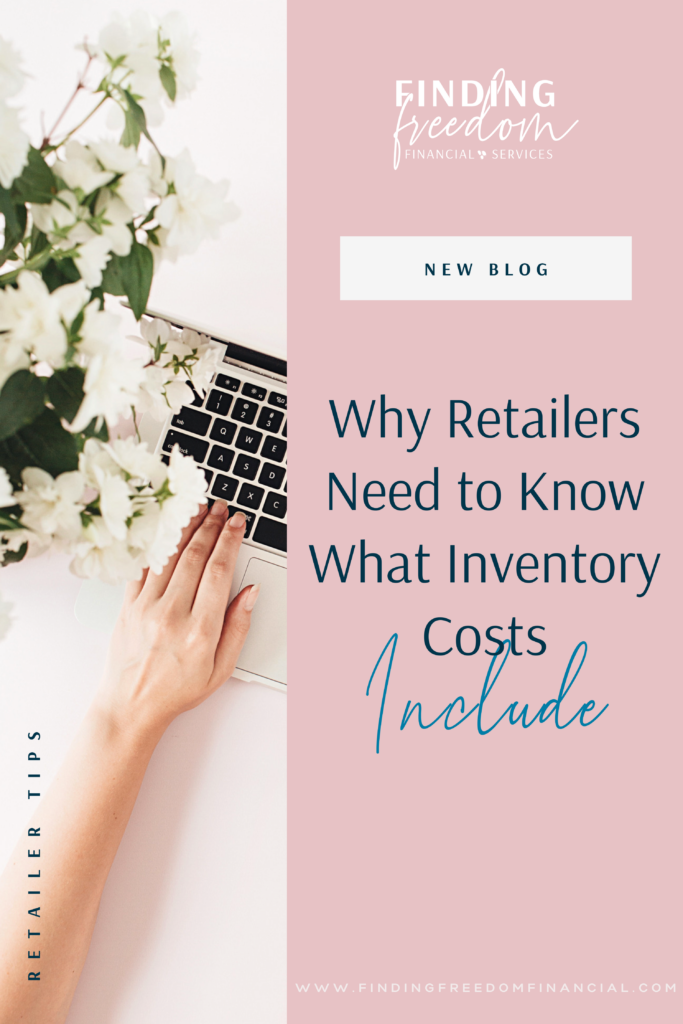Why Retailers Need to Know What Inventory Costs Include
FYI…sometimes I use affiliate links for the resources I love. This means that I may earn a small commission at no extra cost to you. And hey, some of them even include a discount for you!
One of the most important strategies a retailer needs to develop is how they are going to price their products. In order to make sure you’re accurately marking up your products, it’s important for you to know what your inventory costs include.

Proper tracking of inventory, and cost of goods sold, is one of the areas that I see a lot of retailers making mistakes when they do their own bookkeeping. That’s why I’m here to share a little insight today to help you make sure you’re calculating your inventory costs correctly, so you can accurately price your products for PROFIT.
Inventory Costs Include Your Wholesale Costs
This one is kind of a no-brainer, but I did want to emphasize the fact that what you pay for the products in your store should be tracked as an inventory ASSET. These purchases are not considered an expense when you pay for it. Instead, by adding it as an asset, you’re showing that your business owns it, and it actually increases the value of your business if a bank or investor ever takes a look at your balance sheet.
Calculating out your per-product costs when only considering the wholesale costs is fairly simple, as you should be getting some type of invoice or receipt from your wholesaler that lists exactly what you paid per item.
But, don’t consider that your full product cost just yet…
Inventory Costs Include Your Inbound Shipping Costs
That’s right, you also need to include any INBOUND shipping costs to the cost of those products. Let’s do a little simple math here for an example…
Let’s say you bought 20 shirts from a supplier, and they each cost $10 wholesale. The cost of the products alone is $200.
In order to get those 20 gorgeous shirts into your physical or virtual storefront, you need to pay $20 shipping costs for that box of shirts. That brings the total purchase price to $220 for 20 shirts. If you just divide that evenly among the 20 products, you get a product cost of $11. THAT is the number that you should consider as the inventory cost per item, and the number you need to enter into Shopify as your product cost for those items.
How Does this Affect Your Pricing and Profit?
You might be asking yourself…”Do I REALLY need to do this?” And, the answer is yes 🙂 It’s in your best interest, and here’s why…
Let’s look at 2 different scenarios.
In the first scenario, let’s say you only consider the wholesale cost of $10 per shirt as your product cost. And let’s say that you’ve established your markup as 2x your product cost, so you’ll resell that shirt for $20, showing a $10 gross profit for that item.
In the second scenario, you make sure to include the shipping costs in your product cost, so you know your product cost is $11. You keep the same markup of 2x, which gives you a resale price of $22, showing an $11 gross profit for that item.
In the first example, the first $1 of gross profit actually goes to pay for the shipping of that item, leaving you with only $9 gross profit left.
Now, a $2 difference may not seem like a huge amount. But, that’s just on 1 item. If you sell 100 items, that’s $200…1,000 items brings it up to $2,000.
That can make a huge difference on your bottom line.
Want to Learn More?
As a product-based business, inventory is likely your largest investment every single month. As I mentioned at the start, having a solid pricing strategy in place is something that can make or break a retail business.
Now, I consider myself somewhat of an expert when it comes to actually tracking all the expenses & revenue that flow in and out of your business. But, I will be the first to admit that I actually have ZERO retail experience outside of that.
But, because I understand the importance of the strategy that goes into running a successful retail business, I want to invite you to check out the Inventory Genius herself, Ciara Stockeland.
When I first decided to focus on serving the retail industry, I found her book The Inventory Genius, and I’m pretty sure I read it in an afternoon. It provided SUCH great insights on how to use the inventory in your business to produce more profit in your business (and keep more cash), and I highly recommend all inventory-based business owners to read it too!
And, if you want to take it a step further, she recently launched the pre-sale of her BRAND NEW book, The Profit Genius. I can guarantee you that I’ll be reading this one as well, as soon as I can get my hands on it.
In this new book, you’ll learn why keeping cash is better than making more sales. PLUS, the special pre-order price includes a ticket to the LIVE Profit Genius Challenge and the Companion Workbook. But act fast! The pre-order option is only available until September 18th! Use this link to take advantage of the special pre-sale offers!
Here’s to finding your own version of freedom,
Hi, I’m Megan!
Bookkeeping for the retail industry has some unique complexities that take extra time to manage to ensure accuracy. At Finding Freedom Financial Services, I provide done-for-you bookkeeping services for boutique owners that accurately track these complexities for you so you can have more time and focused energy to dedicate to running your stores. If you’re ready to get your time back, apply to work with me today!
